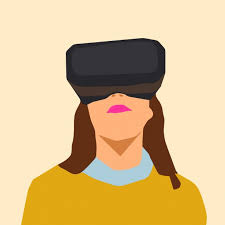Trends in Educational Technology: VR in the Classroom
In her 1993 article “Virtual Reality in the Classroom,” Veronica Pantelidis concludes by detailing the potential of VR in educational environments with a section entitled “The Future.” She predicts “in time, virtual reality may bring greater structure and more consistency, and at the same time, more individualization to what is taught …the learning environment can be manipulated and controlled in new and powerful ways, both by the learner and the teacher” (27). Over fifteen years later, virtual reality is slowly becoming more prominent in education as systems become more affordable and scholars and educators have more opportunities to explore the ways this technology can promote student learning.
From 2013 to 2016 alone, the affordability of VR has increased dramatically. As a result, institutions of higher education of all kinds are able to access this technology, and it is usable across disciplines–from literature to biology to music (McMurtrie). Despite this increase in access, educators are still facing barriers when attempting to incorporate virtual reality into their courses: “VR companies have slashed the prices of goggles, and the computers that run VR have become more plentiful thanks to advances in video cards. At this point, for education, the barrier is not hardware but content” (Bailenson, qtd. in Lieberman). Since large technology companies are developing the software accompanying their VR hardware, if educators do not have the resources at their institutions to develop their own content the practical application of VR in their classroom may be severely limited.
VR companies have developed a variety of different scenarios for users to experience; however, the educational content is not always pedagogically or even ethically sound. Should we transport students to situations with certain backgrounds just because we can? If we do, what issues might arise from placing students in the shoes of someone whose identity may not match their own? In his article “Pros and Cons of Virtual Reality in the Classroom,” Adam Evans cites these issues as well as problems such as physical and emotional health concerns stemming from VR experiences as potential drawbacks. As it exists now, the training and acclimation involved in students adapting to using VR can take quite a bit of time away from instruction.
Incorporating Virtual Reality into the classroom has been a hot-button issue in the Digital Humanities over the past few years. Some humanities based VR projects are fairly straightforward; in both the Commonwealth Shakespeare Company’s Hamlet 360 and New York University’s To Be with Hamlet, participants are provided with a new way to experience the play by viewing it from within the action. These are innovative approaches to interacting with the play, but fairly low risk. While many DH scholars are proponents of incorporating VR into pedagogy and scholarship, it comes with certain risks–particularly when dealing with real people and situations. “To the extent that corporations rather than universities will control the basic assumptions to be applied within the AI algorithms, we are put in the position that our programs will carry cultural, racial and gender assumptions that may not be consistent with our own” (Schroeder). As such, an urgency has developed in ensuring that scholars within a variety of humanities disciplines approach the use of VR with the ethics of care in mind.
While the technology behind VR has improved drastically over the years, the lack of accessibility to relevant content indicates that more work needs to be done. While Pantelidis’s picture of a future containing more access to VR has come true in some ways, the process of incorporating it into the classroom meaningfully has a long way to go.
Works Cited
Evans, Adam. “Pros and Cons of Virtual Reality in the Classroom.” The Chronicle of Higher Education, 8 Apr. 2018, https://www.chronicle.com/article/ProsCons-of-Virtual/243016.
Lieberman, Mark. “Q&A, What Virtual Reality Can (and Could) Do.” Inside Higher Ed, 28 Mar. 2018, https://www.insidehighered.com/digital-learning/article/2018/03/28/expert-virtual-reality-believes-its-higher-ed-impacts-are-still.
McMurtrie, Beth. “Virtual Reality Comes to the Classroom.” The Chronicle of HigherEducation, 27 May 2019, https://www.chronicle.com/interactives/20190528-ImmersiveTech.
Pantelidis, Veronica S. “Virtual Reality in the Classroom.” Educational Technology, vol. 33, no. 4, 1 Apr. 1993, pp. 23-27.
Schroeder, Ray. “VR, AR, AI Worldwide Perspectives.” Inside Higher Ed., 17 Apr. 2019,https://www.insidehighered.com/digital-learning/blogs/online-trending-now/vr-ar-ai-worldwide-perspectives.
Reflection
This week’s assignment gave me an opportunity to explore a topic I’ve been thinking about for a while: the use of virtual reality in the classroom. In Spring 2018, while I was still working as the project manager for a regional university in Illinois, I had the opportunity to participate in the annual Global Digital Humanities symposium here at MSU. One of the keynotes, Lisa Nakamura, gave a talk on the issues and the ethics of using VR in both research and the classroom, particularly since in recent years the technology has become more accessible. In her talk, Nakamura discussed the issues of having large tech companies that primarily employ white men in creating VR content intended to educate and sometimes represent underserved groups. While perusing The Chronicle and Inside Higher Ed, it was interesting to trace how the concerns of using VR in higher education have shifted from access to and the affordability of the technology to investigating how to make VR a viable, meaningful educational experience for all students. As a digital humanist who focuses on Early Modern literature, I knew primarily of VR experiences that involved providing students a new way to experience Shakespeare’s plays and was intrigued to learn of the variety of ways VR is used in different disciplines. Additionally, I wanted to explore how the challenges of using VR in higher education potentially crosses disciplinary bounds.
